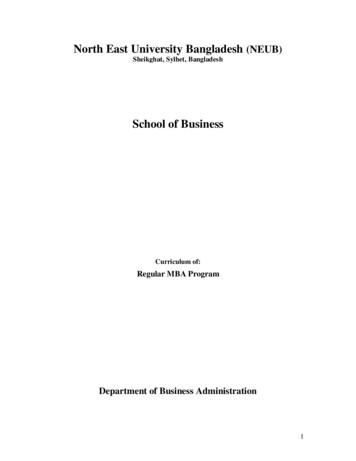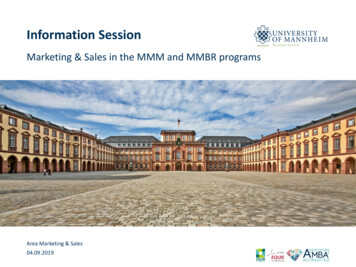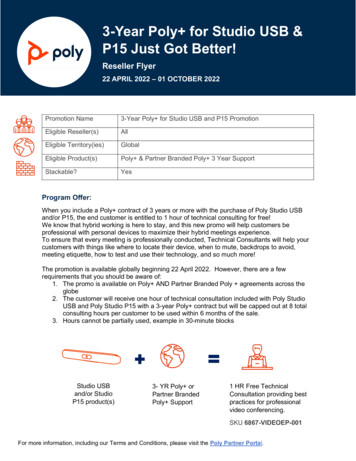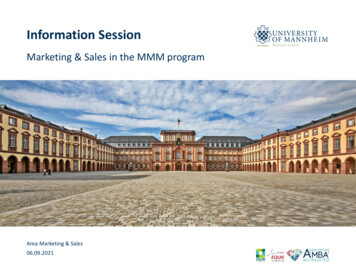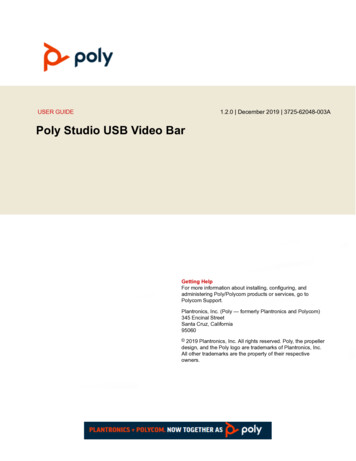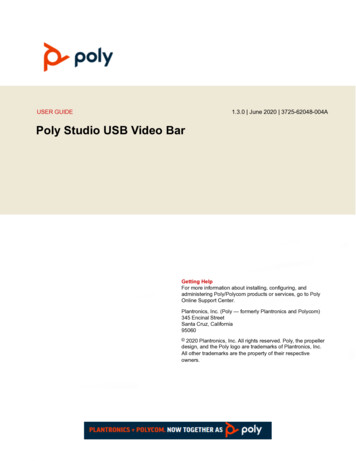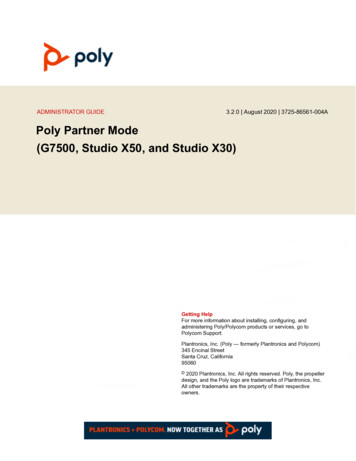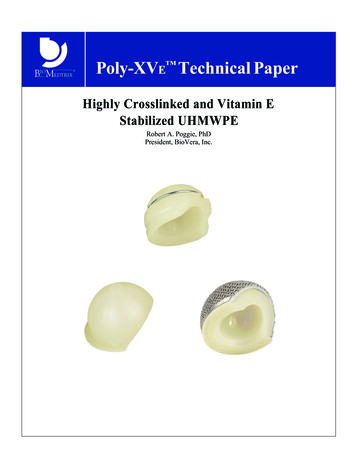
Transcription
Poly-XVE Technical PaperHighly Crosslinked and Vitamin EStabilized UHMWPERobert A. Poggie, PhDPresident, BioVera, Inc.
Our HistoryBioMedtrix was founded in 1989 with the objective of designing, developing, andmanufacturing state-of-the-art veterinary orthopedic implants. Our continuingmission is to provide quality in all aspects of product development, manufacturing,and customer service. Through research sponsorships and collaborations with theworld’s foremost surgeons, BioMedtrix continues to support the development ofnew programs to address veterinary needs.BioMedtrix is represented in more than 95% of US veterinary teaching universities, selectedinternational universities, and specialty clinics throughout the world. We have over 400 clientsin more than 40 countries, many of whom have been using BioMedtrix products for over 30years. This level of support from our customers provides BioMedtrix the opportunity tocontinue product innovation and development.Research and DevelopmentWith over 36 years of development experience in human and veterinary implants, BioMedtrixhas developed proprietary processes, and patented several designs that address clinical needsin the canine hip, knee, elbow, ankle, and trauma fields of orthopaedics. Our research and testingapproaches have demonstrated improved product development cycles with designs that promotelong-term mobility.QualityBioMedtrix operational policies maintain quality standards comparable to those used by humanorthopedic manufacturers. We adhere to all ASTM specifications for implant materials and maintainstandards for articulating surfaces of implants which meet or exceed those specified for human implants.Advisory ProgramBioMedtrix maintains relationships with key veterinarians who provide technical and clinicalfeedback, as well as guidance on product development. These surgeons are specialists inveterinary orthopedics and cumulatively have over 250 years of experience in veterinary medicine.biomedtrix.com
Poly-XVE History of highly cross-linked polyethylene and vitamin E stabilizationand degrades mechanical properties. Also datingback to the late 1990s and 2000s, several elevatedtemperature processes were applied to HCLPEmaterials, with the aims of enhancing crosslinkingand reducing oxidation. However, several of thesemethods were later observed to degrade theproperties and compromise the performance ofHCLPE materials over the long term.Ultra-highmolecularweightpolyethylene(UHMWPE) has been the material of choice forbearing components in joint arthroplasty implantssince the early 1960’s, with its introduction by Dr.John Charnley. However, long-term wear ofUHMWPE and the resulting wear debris is thenumber one cause of peri-prosthetic osteolysis inhuman total joint replacements (TJR) [1-7]. In anattempt to mitigate polyethylene wear, highlycrosslinked polyethylene (HCLPE) was developedin the late 1990s to decrease wear and increaselongevity of TJR devices. HCLPE is a modified formof UHMWPE that has a higher crosslink density thatis realized through irradiation above that necessaryfor sterility assurance. A gamma radiation doserange of 25-40 kGy is typical for sterilizationprocessing, while 75 to 130 kGy is the range forHCLPE. The radiation energy cleaves UHMWPEmolecules that produce free radicals that can inturn cross-link with neighboring UHMWPEmolecular chains [8-10]. However, the residual freeradicals in the crystalline phase of HCLPE can reactwith oxygen which in turn causes oxidativeembrittlement, which reduces resistance to wearBecause of oxidative degradation, UHMWPEresearch in the 2000s focused on processing andadditive means to reduce or prohibit oxidationduring and after crosslinking. Beginning in 2005with a Biomet acetabular implant (FDA clearance #K050327), vitamin E (a-tocopherol) stabilizedHCLPE materials made their debut. Since then,numerous proprietary and broadly available HCLPEw/VE materials have been used to manufacturearticulating surfaces in knees, ankles, and spineimplants. Several examples of commercializedHCLPE w/VE materials are listed below. And thegood news is that this new generation of HCLPEw/VE are withstanding the test of time via reportedevidence of successful clinical use.Examples of commercial brands of HCLPE for hip and knee bearings.COMPANYBRANDVITAMIN ERADIATION TYPESTERILIZATION METHODZimmer BiometVivacit-E YesGamma-BeamGamma-BeamZimmer BiometE1YesGamma-BeamGamma-BeamDePuy-SynthesAOXNo; ‘Covernox’Gamma-BeamGas PlasmaAesculapViteleneYesE-BeamETOCorinECiMa YesGamma-BeamETOConforMISECiMaYesGamma-BeamGas PlasmaMathysVitamys YesGamma-BeamGas PlasmaNextStep, OptimotionVE100 kGyYesGamma-BeamETOBioMedtrixPoly-XVE YesGamma-BeamGamma-Beam 1
Poly-XVE Critical parameters and chemistry in manufacturing HCLPE w/VEUHMWPE Resin, Molding, Sintering: Ultra highmolecular weight polyethylene (UHMWPE) is ahydrocarbon of 2.5 to 5 million molecular weight andis supplied as a medical grade resin by Ticona, Inc.0.1% a - Tocopherol (vitamin E) is blended into GUR1020 resin to create Ticona’s GUR 1020E. To makesolid UHMWPE that can be used to make implants,the resin is molded and sintered under pressure forminutes to hours at elevated temperature. Thequality of the UHMWPE depends on the processparameters and their control.The few companies that make UHMWPE each havetheir own unique equipment and processparameters for time, temperature, and pressure,which in turn means that quality and performancevary from one company’s material to the next.BioMedtrix has chosen Merit UHMWPE from PPDGroup, Inc. because it is the only manufacturer ofsmall batch, direct compression molded UHMWPEwith the industry’s highest level of process controland quality standards. These statements have beenborne out over decades of successful clinicalperformance in humans [32].The below images show Merit direct compressionmolded stock materials and shoulder, knee, and hipimplants machined from the bar stock. The imageson the right show standard UHMWPE and HCLPEw/VE knee and hip implants highlighting the yellowhue of products that are manufactured with VitaminE containing UHMWPE. Crosslinking furtheraccentuates the yellow hue.2
Poly-XVE Crosslinking: Crosslinking refers to the chemicalbonding of neighboring molecules of UHMWPE in athree-dimensional, dense molecular network withinthe amorphous regions of the material. This processcan occur via chemical or ionizing radiation thatcleaves UHMWPE molecules that activate theUHMWPE molecules towards cross-linking,recombination, and/or oxidation. The two methodsfor crosslinking orthopaedic UHMWPEs are gammaand electron beam radiation, which coincidentallyare two historical methods for terminal sterilization.The primary reason for crosslinking UHMWPE is toincrease resistance to wear. The tradeoffs aredeceases in ductility, toughness, and resilience ofUHMWPE that become clinically significant andunacceptable at radiation levels greater than 150kGy. Because of this relationship, contemporaryHCLPE materials are irradiated in a range of 75 to130 kGy.Decreasing hip wear with increasing radiation x-linkingDecreasing toughness with increasing radiationThere have been multiple in vitro and in vivo studiesthat show significant increased resistance to wear ofUHMWPE via cross-linking (50 – 130 kGy), rangingbetween 70 to 95% less wear relative toconventional UHMWPE (25-40 kGy) [21-27]. Forexample, a study of patients over five (5) years foundthe annual wear-rate of HCLPE acetabular liners tobe 0.02 mm/yr, while conventional UHMWPE woreat a rate of 0.12 mm/yr [21-26]. More recent studies ofthermally annealed HCLPE, that was not vitamin Estabilized, also showed a significant improvement inwear resistance over conventional UHMWPE up to10 years [22,23], which unfortunately was followed bya rapid increase in wear through 15 years [25]. Thisfinding has been repeated many times and in turnleading the industry towards HCLPE materials withVitamin E.Vitamin E (a - Tocopherol) Anti-Oxidative Additive:Currently, not all companies in the humanorthopedic marketplace are using HCLPE withVitamin E or other anti-oxidation additive; but that ischanging quickly. It is probable that non-stabilized,non-crosslinked UHMWPE will be history come2025 or thereabouts for three reasons. The first isthe overwhelming laboratory evidence of reducedwear and oxidation of HCLPE w/VE, the second isthe rapidly accumulating evidence of clinicalsuccess of several proprietary and more broadlyavailable variants of HCLPE w/VE, and third is theFDA now recognizes HCLPE w/VE materials as thenew ‘standard’, supplanting 25-40 kGy conventionalUHMWPE [3,15-18].Vitamin E stabilized UHMWPE is created byblending a - Tocopherol with GUR 1020 UHMWPEresin (0.1% by weight) to create a homogenousmixture of GUR 1020E resin that is molded,sintered, and gamma irradiation cross-linked [3,20].The objective of fortifying UHMWPE with vitamin Eis to prohibit oxidation and preserve the mechanicaland wear-resistant properties of the HCLPEmaterial.3
Poly-XVE This stabilizing effect becomes more importantduring and after crosslinking, and as a function ofincreased level of crosslinking. For example,HCLPE at 130 kGy is more susceptible to oxidationthan 50 kGy material. The mechanism of action ofVitamin E within UHMWPE is relatively simple in thatthe a – Tocopherol molecule reacts with theactivated, cleaved chains of UHMWPE (called freeradicals) that did not crosslink or recombine duringradiation exposure. In other words, during and afterradiation crosslinking, vitamin E effectivelyterminates active free radicals not alreadycrosslinked with neighboring UHMWPE molecules.The vitamin E also combines with oxygen within theUHMPWE. Both chemical phenomena are veryeffective in virtually eliminating oxidation of HCLPEduring and after cross-linking, and very importantly,with minimal reduction in mechanical resilience[3,7,11-14].What is the clinical outcome in human medicine?The HCLPE w/VE has been followed clinically sincethe late 2000s. Several clinical studies havedocumented a reduction in wear in hip and knees,with comparison to conventional polyethylene. Forexample, in hip clinical studies, the mean femoralhead penetration rate significantly improved(0.003mm/yr.) as compared to the controlconventional polyethylene group (0.051mm/yr) [3,2631]. Below are excerpts from the concluding remarksfrom six recent publications regarding clinicaloutcomes with HCLPE w/VE materials [33-38].2020 Acta Scandinavia, Goulven Rochcongar,et.al., “Wear rates continue to be lower inHXLPE/VitE cups than in UHMWPE cups at 5 yearsof follow-up without correlation with increasing cupinclination angles or cup sizes. Finally, HXLPE/VitEcups may have the potential to prevent osteolysisand implant loosening.”2019 Hip International, Michael C Wyatt, et.al., “At aminimum of 3 years follow-up there was reducedtotal femoral head penetration for vitamin E HXLPEover HXLPE.”2018 JBJS, G. Rochcongar, MD, et.al.: “Our resultsconfirm that wear rates over the first 3 yearsfollowing surgery were lower in HXLPE/VitE cups4than in UHMWPE cups. This suggests thatHXLPE/VitE cups may prevent osteolysis, implantloosening, and eventually revision surgery.”2018 Orthopaedic Proceedings, Malchau, et.al.:“The current study (of Vit E stabilized x-linked) is thelargest analysis of polyethylene wear at five-yearfollow-up using RSA. We observed similar beddingin through the two-year interval between the twoliner types, however, there was significantly morewear for the ModXL cohort at five-years.”2017 JBJS, Shareghi, et.al.: “The penetration ratewas higher for ArComXL (versus E1 poly), resultingin more proximal and total penetration at 5 yearsthan for E1.”2016 International Orthopaedics, Scemama, et.al.:“This study demonstrated that femoral headpenetration was lower when using vitamin Eblended HXLPE when compared with UHMWPE,with a steady-state penetration rate far below theosteolysis threshold.”These statements are representative of theconsensus that has developed in the past severalyears regarding HCLPE w/VE; namely that the stateof-the-art joint replacement includes the use ofHCLPE w/VE [33-38].
Poly-XVE What tests have been performed on Poly-XVE?Mechanical property tests were performed to ASTMF2977-13 on the following samples:1. Sample #1: current UHMWPE(Ultra High Molecular WeightPolyethylene) gamma irradiatedto 25 kGy2. Sample #2: competitive human HCLPE(Highly Crosslinked Polyethylene) withvitamin E gamma irradiated to 100 kGy3. Sample #3: BioMedtrix Poly-XVE (HighlyCrosslinked Polyethylene with vitamin E)gamma irradiated to 125kGyThese results confirm the additional gammaradiation has not changed the mechanical propertiesof the Poly-XVE.SAMPLE INITIAL PEAK LOAD (N)ULTIMATE LOAD (N)167.1 4.174.8 4.9267.6 1.475.9 10.2368.6 2.373.9 2.4Data courtesy of PPD Industries, Inc.In addition, the benefits from this cross linking withreduced oxidation through the vitamin Edemonstratessignificantlyimprovedwearproperties both in laboratory testing and clinicalfollow-up in human total joint replacements.5
Poly-XVE Does highly cross-linked polyethylene with vitamin E have a place inveterinary orthopedics?Yes.Although polyethylene wear has not been afrequent clinical issue in veterinary total jointreplacement, there remains an interest inimproving shelf life of polyethylene implants andreducing long term wear in young THR patients.Provided the cost of this technology is affordableand reasonable, the product should be offered asan option.Lab testing of the BFX Cup (Tech Report No.170904-1 and 180929-1) with highly crosslinkedpoly and Vitamin E demonstrated no issues in theassembly of the liner, impaction into polyurethanefoam or in cadaver evaluations. There is nodifference in surgery.The BioMedtrix Poly-XVE material is based onHCLPE with Vitamin E which has successfulclinical outcomes in human TJR applications.HCLPE w/VE has a more yellowishappearance due to the added Vitamin E.Assembled BFX Cup with HCLPE w/VEInsert (post sterilization)6
Poly-XVE What will be the increased cost for BioMedtrix products using Poly- XVE?The cost of the material will be more expensive than conventional polyethylene. However, with sufficient quantitypurchase of the raw material, the part cost increase will be less than 100.00.What products will be converted to Poly-XVE?The first product to utilize Poly-XVE will be the BFX Cup liner. All sizes will be offered with the Poly-XVEliners as an option for the younger patients where poly wear over a long period of time could be a concern.Other products which will be offered in Poly-XVE will include the CFX Cups, the Micro & Nano CFX Cups, thenew BFX Micro & Nano Cup liners (currently in development), TKR tibial bearings and the TATE Elbow radioulnar bearing.SummaryBioMedtrix Poly-XVE is a highly crosslinked polyethylene with vitamin E from validated human medicalsuppliers. Implants are manufactured from this material by an ISO 13485 facility specializing in the productionof polyethylene implants for human orthopedic companies.In human total joint replacements, HCLPE w/VE has become the standard material for the implant bearingsurfaces when using polyethylene. It is likely become the only material available in the future as the materialmanufacturers have a responsibility to provide the best products based on clinical outcomes.BioMedtrix utilizes UHMWPE that is part of FDA Master File, MAF #2795, titled “PPD Merit UHMWPEMaterials.”7
Poly-XVE References1. Biomet Biomaterials Laboratory Warsaw Indiana. “The Revolutionary Second Generation, Vitamin E Stabilized HighlyCrosslinked UHMWPE.” Zimmer Biomet.2. Grupp TM, et.al. Biotribology of a vitamin E-stabilized polyethylene for hip arthroplasty – Influence of artificial aging and thirdbody particles on wear. Acta Biomaterialia 10 (2014) 3068-3078.3. Gigante, Antonio et al. “Effectiveness of Vitamin-E-Doped Polyethylene in Joint Replacement: A Literature Review.” Ed.Rajshree Mootanah. Journal of Functional Biomaterials 6.3 (2015): 889–900. PMC.4. Michael P. Ast, Thomas K. John, Anthony Labbisiere, Nicolas Robador, Alejandro Gonzalez Della Valle. “Fractures of a SingleDesign of Highly Cross-Linked Polyethylene Acetabular Liners: An Analysis of Voluntary Reports to the United States Foodand Drug Administration.” The Journal of Arthroplasty. Volume 29, Issue 6, 2014. Pages 1231-12355. Orhun K Muratoglu, Evan S Greenbaum, Charles R Bragdon, Murali Jasty, Andrew A Freiberg, William H Harris. SurfaceAnalysis of Early Retrieved Acetabular Polyethylene Liners. The Journal of Arthroplasty. Volume 19, Issue 1, 2004. Pages 68776. Plank, G. R., Estok, D. M., Muratoglu, O. K., O’Connor, D. O., Burroughs, B. R. and Harris, W. H. “Contact Stress Assessmentof Conventional and Highly Crosslinked Ultra High Molecular Weight Polyethylene Acetabular Liners with Finite ElementAnalysis and Pressure Sensitive Film.” J. Biomed. Mater. Res., 80B: 1–10.7. Zimmer Biomet white paper. “Vivacit-E Vitamin E Highly Crosslinked Polyethylene Long-Term Performance for High DemandPatients.”8. Sutula L, Collier J, Saum K, Currier B, Currier J, Sanford W, et al. The Otto Aufranc Award. Impact of gamma sterilization onclinical performance of polyethylene in the hip. Clin Orthop. 1995;(319):28–40.9. Willert H, Bertram H, Buchhorn G. Osteolysis in alloarthroplasty of the hip. The role of bone cement fragmentation. ClinOrthop. 1990;258:108–121.10. Willert HG, Bertram H, Buchhorn GH. Osteolysis in alloarthroplasty of the hip: The role of ultra-high molecular weightpolyethylene wear particles. Clin Orthop. 1990;258:95–107.11. Muratoglu OK, Kurtz S. Alternate Bearing Surfaces in Hip Replacement. In: Sinha R, editor. Hip Replacement. Current Trendsand Controversies; New York, NY: 2002. pp. 1–46.12. Oral E, Wannomae KK, Rowell SL, Muratoglu OK. Diffusion of vitamin E in ultra-high molecular weight polyethylene.Biomaterials. 2007;28:5225–5237. doi: 10.1016/j.biomaterials.2007.08.025.13. Oral E, Muratoglu OK. Vitamin E diffused, highly crosslinked UHMWPE: a review. Int Orthop. 2011;35:215–223. doi:10.1007/s00264-010-1161-y.14. Kurtz SM, Dumbleton J, Siskey RS, Wang A, Manley M. Trace concentrations of vitamin E protect radiation crosslinkedUHMWPE from oxidative degradation. J Biomed Materials Res. Part A. 2009;90:549–563. doi: 10.1002/jbm.a.32122.15. Haider H, Weisenburger JN, Kurtz SM, Rimnac CM, Freedman J, Schroeder DW, Garvin KL. Does vitamin E-stabilizedultrahigh-molecular-weight polyethylene address concerns of cross- linked polyethylene in total knee arthroplasty? JArthroplasty. 2012;27:461–469. doi: 10.1016/j. arth.2011.03.024.16. Dumbleton JH, D’Antonio JA, Manley MT, Capello WN, Wang A. The basis for a second-generation highly cross-linkedUHMWPE. Clin Orthop Relat Res. 2006;453:265–271.17. Bracco P, Oral E. Vitamin E-stabilized UHMWPE for total joint implants: a review. Clin Orthop Relat Res. 2011;469:2286–2293. doi: 10.1007/s11999-010-1717-6.18. Affatato S, Bracco P, Costa L, Villa T, Quaglini V, Toni A. In vitro wear performance of standard, crosslinked, and vitamin-Eblended UHMWPE. J Biomed Materials Res. Part A. 2012;100:554–560. doi: 10.1002/jbm.a.33297.19. Collier JP, Currier BH, Kennedy FE, Currier JH, Timmins GS, Jackson SK, Brewer RL. Comparison of cross-linkedpolyethylene materials for orthopaedic applications. Clin Orthop Relat Res. 2003;414:289–304. doi:10.1097/01.blo.0000073343.50837.03.20. Oral E, Wannomae KK, Rowell SL, Muratoglu OK. Diffusion of vitamin E in ultra-high molecular weight polyethylene.Biomaterials 2007;28(35):5225-37.8
Poly-XVE 21. Oral E, Wannomae KK, Kawkins NE, Harris WH, Muratoglu OK. Alpha-tocopherol doped irradiated UHMWPE for highfatigue resistance and low wear. Biomaterials 2004; 25(24):5515-22.22. Devane Peter A., et.al. Highly Cross-Linked Polyethylene Reduces Wear and Revision Rates in Total Hip Arthroplasty. J BoneJoint Surg Am 2017; 99:1703-1714.23. Lachiewicz Paul F, et.al. Highly-Cross Linked Polyethylene Provides Decreased Osteolysis and Reoperation at Minimum 10Year Follow-Up. J Arthroplasty 31 (2016); 1959-1962.24. Edidin AA, Pruit L, Jewett CW, Crane DJ, Roberts D, Kurtz SM. Plasticity-induced damage layer is a precursor to wear inradiation-cross-linked UHMWPE acetabular components for total hip replacement. Ultra-high-molecular-weight polyethylene. JArthroplasty 1999;14(5):616-27.25. Mayer Constantin, et.al. Wear Kinetics of Highly Cross-Linked and Conventional Polyethylene Are Similar at Medium-termFollow-Up After Primary Total Hip Arthroplasty. J Arthroplasty 33 (2018); 2671-2676.26. Oral, E.; Greenbaum, E.S.; Malhi, A.S.; Harris, W.H.; Muratoglu, O.K. Characterization of irradiated blends of -tocopherol andUHMWPE. Biomaterials 2005, 26, 6657–6663.27. Digas G, Karrholm J, Thanner J, Malchau H, Herberts P. The Otto Aufranc Award. Highly cross-linked polyethylene in total hiparthroplasty: randomized evaluation of penetration rate in cemented and uncemented sockets using radiostereometricanalysis. Clin Orthop Relat Res. 2004;429:6–16. doi: 10.1097/01.blo.0000150314.70919.e3.28. Digas G, Karrholm J, Thanner J, Malchau H, Herberts P. Highly cross-linked polyethylene in cemented THA: randomized studyof 61 hips. Clin Orthop Relat. 2003;417:126–138.29. D’Antonio JA, Manley MT, Capello WN, Bierbaum BE, Ramakrishnan R, Naughton M, Sutton K. Five-year experience withcrossfire highly cross-linked polyethylene. Clin Orthop Relat Res. 2005;441:143–150. doi: 10.1097/00003086-20051200000024.30. Collier JP, Currier BH, Kennedy FE, Currier JH, Timmins GS, Jackson SK, Brewer RL. Comparison of cross-linkedpolyethylene materials for orthopaedic applications. Clin Orthop Relat Res. 2003;414:289–304. doi:10.1097/01.blo.0000073343.50837.03.31. Jasty M, Rubash HE, Muratoglu O. Highly cross-linked polyethylene: the debate is over—in the affirmative. J Arthroplasty.2005;20:55–58. doi: 10.1016/j.arth.2005.03.015.32. G.A. Macheras et al. Survivorship of a Porous Tantalum Monoblock Acetabular Component in Primary Hip Arthroplasty With aMean Follow-Up of 18 Years, J Arthroplasty 32 (2017) 3680e3684. doi.org/10.1016/j.arth.2017.06.049.33. Rochcongar G, et.al. Reduced wear in Vitamin E-infused highly cross-linked polyethylene cups: 5-year results of a randomizedcontrolled trial. Acata Orthopaedica, DOI: 10.1080/17453674.2020.18572785.34. Michael C Wyatt, et.al. Does vitamin E highly cross-crosslinked polyethylene convey an advantage in primary total hipreplacement? A systematic review and meta-analysis. HIP International , DOI.org/10.1177/1120700019858335. June 2019.35. G Rochcongar, et.al. Creep and Wear in Vitamin E-Infused Highly Cross-Linked Polyethylene Cups for Total HipArthroplasty.JBJS Vol. 100-A, No.2 (2018); 107-114.36. M H Galea, et.al. Evaluation of In Vivo Wear of Vitamin E-Stabilized Highly Crosslinked Polyethylene at Five Years: AMulticentre Radiosterometric Analysis Study. Orthopaedic Proceedings, 2018, British Editorial Society of Bone and JointSurgery.37. Bita Shareghi, et.al. Wear of Vitamin E-Infused Highly Cross-Linked Polyethylene at Five Years. JBJS Vo. 99-A, No. 17,September 6, 2017.9
About the author:Dr. Robert Poggie has worked in the orthopaedic industry since 1992 with experience in applied research,regulatory affairs, clinical outcomes, and medical education. Bob was instrumental in the research anddevelopment of Smith & Nephew’s Oxinium and Implex’s Hedrocel biomaterial (now part of Zimmer Biomet),which is now trade named Trabecular Metal. Since 2009, Bob has been an industry consultant (BioVera) forregulatory affairs, applied research, device testing, and commercialization. Prior to BioVera, Bob was a Directorat Zimmer TMT, where he managed applied research, regulatory and clinical affairs. He was responsible fornumerous regulatory clearances for spinal, hip, knee, and shoulder products with the US FDA and for CE Mark,as well as the training materials for prospective surgeon users and sales associates. Prior to Zimmer, Bob directedApplied Research and Regulatory Affairs for Implex Corp., which included research, university-based testing,and global regulatory approvals. He managed FDA regulated investigational studies, which included therecruitment of surgeon investigators, data compilation, and publication of results. Prior to Implex, Bob was asenior research engineer for Smith & Nephew, responsible for metallurgical and tribological research. Bob haspublished numerous peer reviewed papers and presented globally as invited faculty for conferences andeducation courses. Bob earned a BE in Mechanical Engineering, and MS and PhD degrees in Materials Science &Engineering, all from Vanderbilt University in Nashville, TN.9 Whippany Road, Suite B2-7 Whippany, New Jersey 07981 telephone 973.331.7800biomedtrix.comMKT-TD-0034-A
human total joint replacements (TJR)[1-7]. In an attempt to mitigate polyethylene wear, highly crosslinked polyethylene (HCLPE) was developed in the late 1990s to decrease wear and increase longevity of TJR devices. HCLPE is a modified form of UHMWPE that has a higher crosslink density that is realized through irradiation above that necessary for sterility assurance. A gamma radiation dose .
